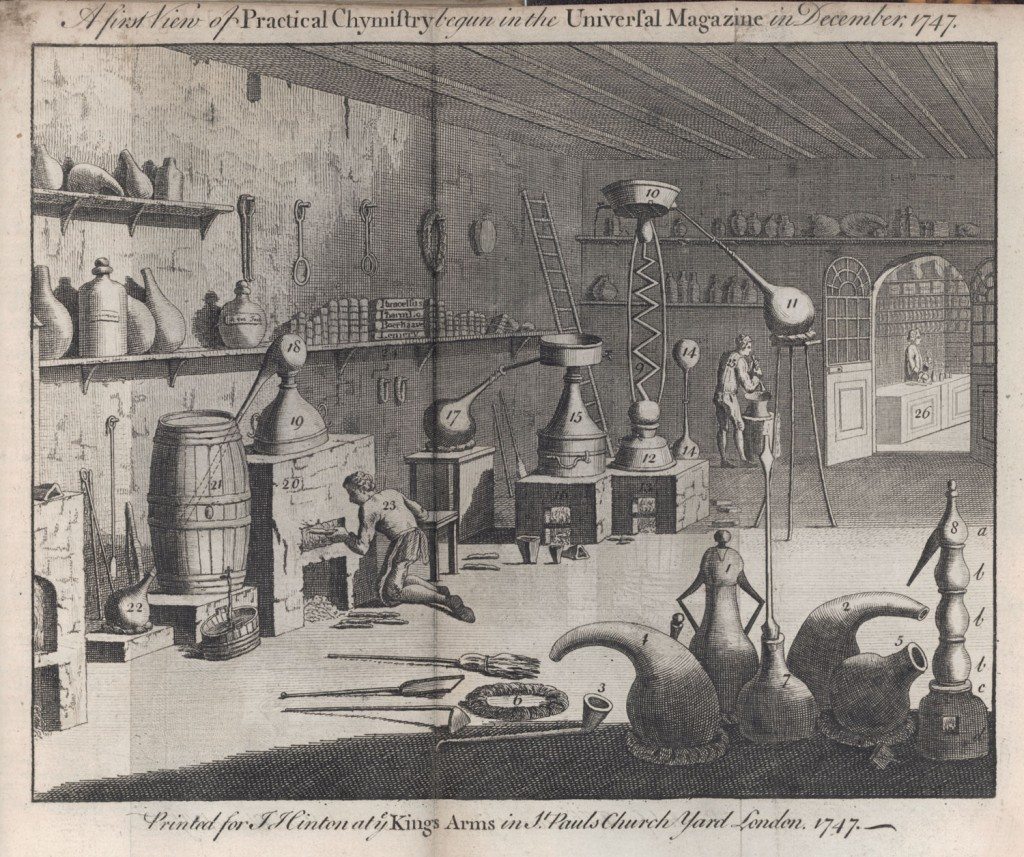A First View of Practical Chymistry (Chemistry), The Universal Magazine, vol. 1, December 1747
The copper-plate print and text form the first part of a “complete Course of Chemistry in several lectures” by an inhabitant of Warwick Lane in London who calls himself “Chemicus”. The writer notes how chemistry originated in Asia and Egypt and was practised under the name alchemy in Arabia. He explores its spread into other nations and chemistry’s practical uses in medicine. He provides an indication of the scope of the subject through a detailed diagram, which contains the following:
1. a retort;
2. a pelican or circulatory vessel;
3. a crooked glass-pipe;
4. a tabulated retort;
5. a receiver;
6. a roundel to set glasses on;
7. a receiver with a glass-pipe adjusted to it, to make a vessel for digestion;
8. a subliming furnace, divided into several parts a-d;
9. the tin serpentine;
10. the glass-head;
11. the recipient of the serpentine;
12. the copper-tinned vessel, containing aqua vitae;
13. a furnace for diluting aqua vitae;
14. a matrass of rencounter;
15. the vaporous bath;
16. the furnace of the vaporous bath;
17. the receiver to the vaporous bath;
18. the moor or death’s head;
19. a copper vessel tinned within;
20. the furnace;
21. a barrel containing water to cool the liquor that distils and the pipe that carries the liquor into the recipient;
22. the recipient;
23. the chemist at work;
24. a shelf of chemical books, etc.;
25. a labourer beating drugs in a mortar;
26. an apothecary’s shop.
Chemicus aims to continue his course and concludes: “I propose to delineate the Theory of this sublime art; in which I shall discourse of Metals, Salts, Sulphur, Stones, Vegetables, Animals, and of the benefit of this art of Chemistry in Natural Philosophy, and the mechanic arts, as well as in Physic.”
Chemistry had become part of the culture of an educated man by the mid 18th century. The Royal Society provided an intellectual focus and travelling lecturers used chemical experiments as part of their repertoire as educators and entertainers. An understanding of chemistry became an important requirement for agricultural improvement, the ceramics industry and metal manufacturing. In the late 18th century, the inventors and entrepreneurs of the Lunar Society such as Matthew Boulton, Samuel Galton junior, James Keir, Joseph Priestley and Josiah Wedgwood engaged in the theoretical study of chemistry and its practical application.
Source: The Universal Magazine, vol. 1, December 1747 (London, John Hinton, 1747), pp 331-333.






